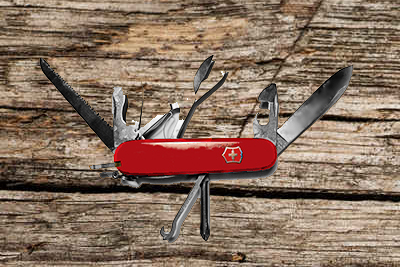- Trips
- Tour Calendar
- About Our Tours
- Plan a Trip
- Book a Trip
- About Us
- Contact Us


Few things are more closely associated with Switzerland than the iconic Swiss Army knife. It seems that hardly a single traveler visits Switzerland without leaving with one in his or her pocket.
In the late 1880s, before there was ever an official Swiss Army knife, the Swiss Army decided to purchase a simple folding pocket knife for their soldiers. This knife was intended for use by the army in opening canned food and disassembling the M1889 Swiss service rifle which required a screwdriver for assembly.
At that time, no Swiss company had the production capacity to supply the knives, so the initial order for 15,000 knives was filled by the German knife manufacturer Wester & Co. from Solingen, Germany. These knives were delivered in October 1891 and designated Modell 1890. The knife had a single blade, reamer, can opener, and screwdriver, with grips made out of dark oak.
In 1891, Karl Elsener, the owner of a company that made surgical equipment, sought to manufacture the knives in Switzerland, and by the end of 1891 Elsener took over production of the Modell 1890 knives. But Elsener was not satisfied with the knife’s design. In 1896, Elsener created a design in which tools were attached on both sides of the handle using a spring mechanism. This innovation allowed him to use the same spring to hold all the tools in place, thereby putting twice as many features on the knife. In 1897 this knife featuring a second smaller cutting blade, corkscrew, and wood fiber grips was originally registered with the patent office as The Officer's and Sports Knife, though it was never part of a military contract.
In 1893, the Swiss cutlery company Paul Boéchat & Cie, which later became Wenger, received its first contract from the Swiss military to produce Modell 1890 knives. Both companies, Paul Boéchat (Wenger) and Elsener (later to become Victorinox), used the cross and shield to identify their knives—a symbol still used today. While Wenger touted itself as the “Genuine Swiss Army Knife,” Victorinox laid claim to being the “Original Swiss Army Knife.” The two companies split the contract for providing knives to the Swiss Army from 1908 until Victorinox acquired Wenger in 2005.
When Karl Elsner’s mother died in 1909, Elsener renamed his company "Victoria" in her memory. In 1921 the company started using newly invented stainless steel to make the Swiss Army Knife. Stainless steel is known as "inox", short for the French term acier inoxydable. "Victoria" and "inox" were then combined to create the portmanteau "Victorinox", the name still used today.
Ever practical, the Swiss Army knife was primarily a tool used by soldiers, which prompted the popular name in English “Swiss Army knife,” a term coined by American soldiers who had difficulty pronouncing their German name, “Schweizer Offiziersmesser,” or “Sackmesser” in the local Swiss-German dialect. To this day, each military recruit (which includes most of the male population, since the Swiss have compulsory military service for all men when they reach the age of adulthood) receives a Swiss Army knife upon beginning their service. Ironically, Victorinox, a company founded to keep Swiss soldiers from carrying German-made knives, is now the official supplier of pocket knives to the German Army.
 The Swiss Army Knife Today
The Swiss Army Knife TodayToday, the "Officers' Knife" is available in over 100 different models. The Victorinox headquarters, manufacturing facility, and show room are located in the Swiss town of Ibach. Each day, over 34,000 of these pocket tools leave the factory, where 90% are for export to over 100 different countries around the globe and serve as ambassadors for Switzerland.
Swiss Army Knives can be purchased at stores throughout Switzerland and they make wonderful gifts. Most major retailers who sell Swiss Army Knives will also engrave a name on the handle of the knife at little or no additional cost—making these classic knives the perfect personalized gift for friends and relatives back home. A visit to the Victorinox factory in the town of Ibach in central Switzerland can be included on any Alpenwild private or custom tour.